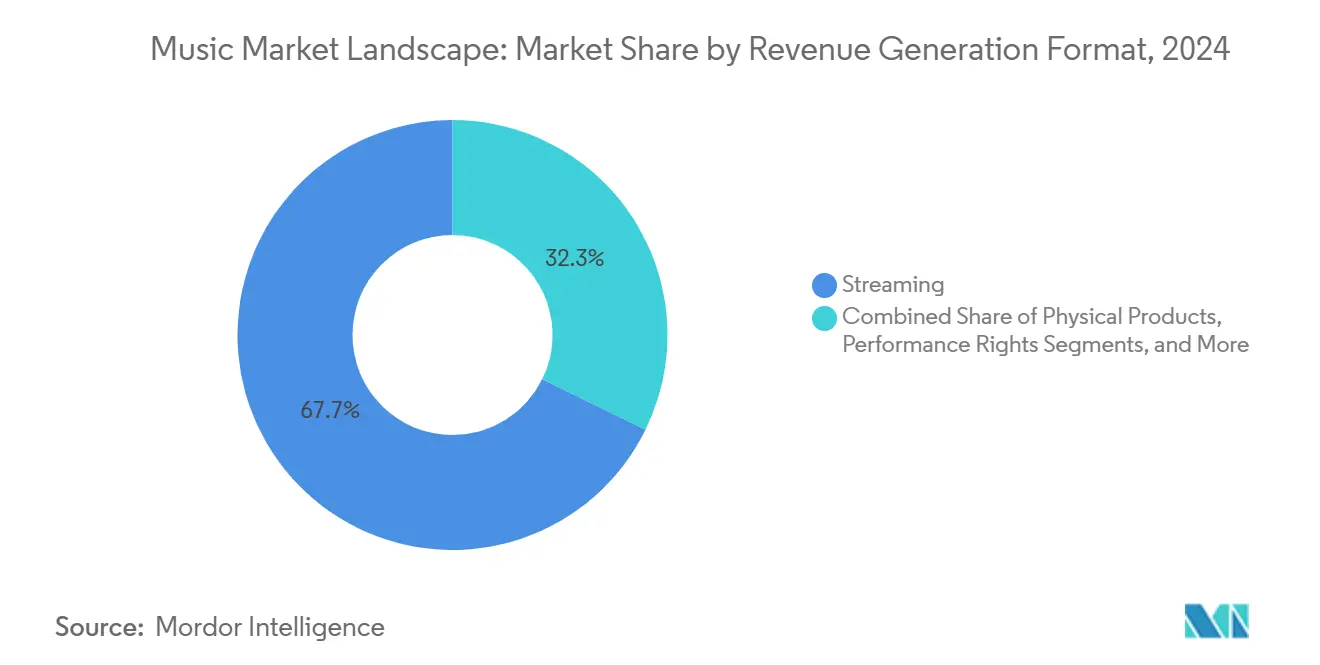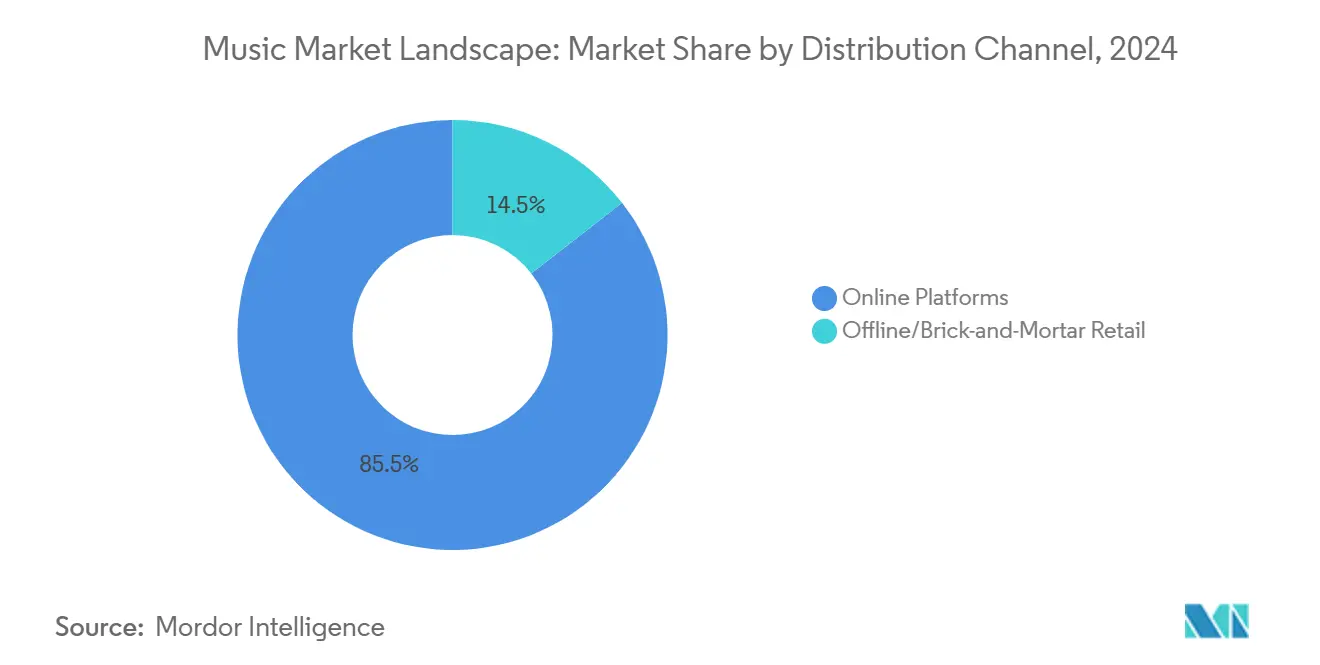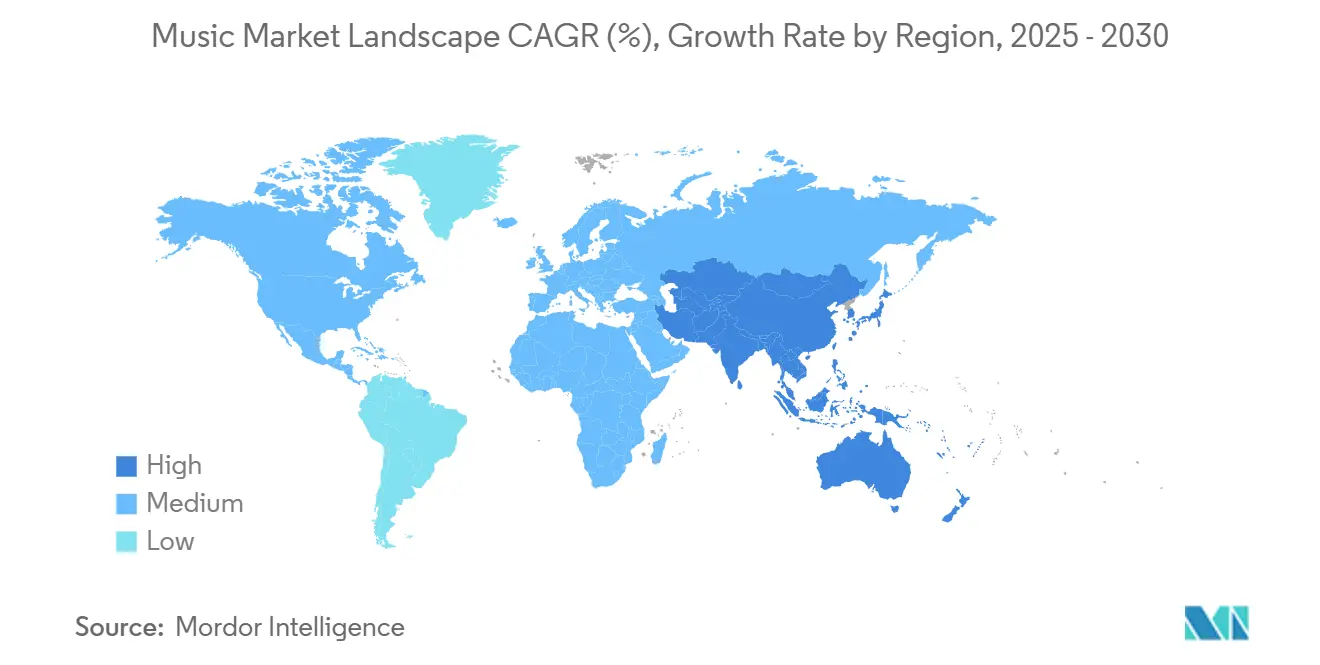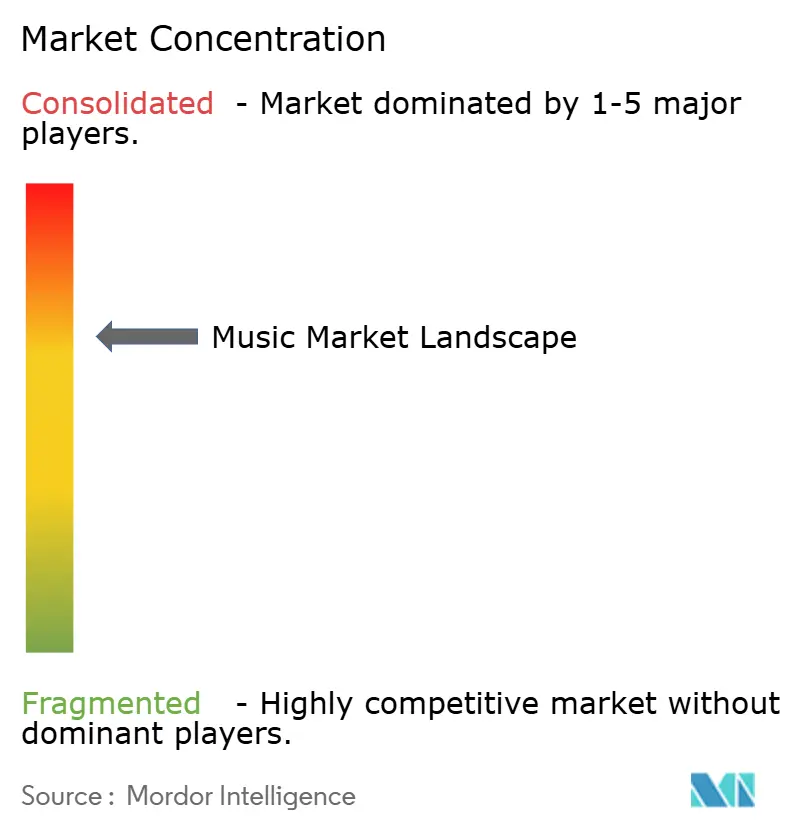Music Market Size and Share

Music Market Analysis by Mordor Intelligence
The global music market size is USD 33.32 billion in 2025 and is projected to reach USD 50.20 billion by 2030, reflecting an 8.54% CAGR during the forecast period. Streaming commands 67.73% music market share in 2025, reaffirming the sector’s ongoing shift from physical formats toward access-based consumption. Parallel expansion in performance rights, live experiences, and commercial licensing adds depth to overall revenue growth. Smartphone penetration, better bandwidth, and rising disposable incomes in emerging economies amplify demand momentum, while catalog acquisitions and immersive audio formats reinforce premium-tier monetization. Competitive strategies prioritize vertical integration and data-driven A&R, and opportunities arise in B2B licensing, localized content, and direct-to-fan ecosystems.
Key Report Takeaways
- By revenue generation format, streaming held 67.73% of the music market share in 2025; performance rights are advancing at a 9.21% CAGR through 2030.
- By genre, pop captured 27.65% share of the music market size in 2025 and Latin music is forecast to expand at an 8.79% CAGR to 2030.
- By distribution channel, online platforms accounted for 85.54% of the music market size in 2025, while brick-and-mortar retail is contracting at a 14.9% annual rate.
- By end user, individual consumers retained 82.32% share of the music market size in 2025; commercial establishments record the fastest growth at 9.76% CAGR to 2030.
- By geography, Asia Pacific is advancing at a 9.12% CAGR in the music market, even as North America preserved 34.53% 2024 share.
- Universal Music Group, Sony Music Entertainment, and Warner Music Group collectively held roughly 65–70% of global revenue in 2025.
Global Music Market Trends and Insights
Drivers Impact Analysis
| Driver | (~) % Impact on CAGR Forecast | Geographic Relevance | Impact Timeline |
|---|---|---|---|
| Accelerated adoption of music-streaming subscriptions | +2.1% | Global, highest in Asia Pacific and Latin America | Medium term (2–4 years) |
| Rising smartphone and internet penetration | +1.8% | Asia Pacific, Latin America, Middle East and Africa | Long term (≥ 4 years) |
| Growth of social media and short-form video | +1.4% | Global, highest in North America and Asia Pacific | Short term (≤ 2 years) |
| Strong investment and catalog acquisitions | +1.2% | Global, concentrated in North America and Europe | Medium term (2–4 years) |
| Proliferation of immersive audio formats | +0.9% | North America, Europe, developed Asia Pacific | Long term (≥ 4 years) |
| Blockchain-enabled direct-to-fan models | +0.6% | Global, early adoption in North America and Europe | Long term (≥ 4 years) |
| Source: Mordor Intelligence | |||
Accelerated Adoption of Music-Streaming Subscriptions
Premium-tier optimization now outweighs basic subscriber acquisition. Spotify’s USD 4.5 billion payout to independent labels and publishers in 2024 illustrates elevated royalty throughput, yet the platform’s emphasis has shifted toward lossless codecs, exclusive drops, and bundled virtual events that lift ARPU. High-value tiers foster richer data analytics, shaping artist discovery and marketing spend efficiency. Developed markets focus on price segmentation, while emerging regions deliver sheer volume growth backed by mobile payment integration. The driver elevates total streams, boosts performance rights, and underpins cross-channel bundling for live-streamed concerts.[1]“Spotify Financial Filings 2024,” Spotify, investors.spotify.com
Rising Smartphone and Internet Penetration in Emerging Markets
Infrastructure upgrades across India, Indonesia, and Brazil unlock new listener cohorts, establishing mobile-first consumption norms that bypass physical retail constraints. India’s recorded-music revenue climbed to USD 1.9 billion (INR 24 billion) in 2024 and is poised to hit USD 2.9 billion (INR 37 billion) by 2026, a 14.7% CAGR, propelled by regional-language catalogs and low-cost data plans.[2]“Global Music Revenue Report 2025,” IFPI, ifpi.org Monetization remains skewed toward ad-supported tiers, yet localized content commands higher engagement and advertising premiums. Embedded micro-payment options empower direct artist-to-fan transactions, shrinking intermediary margins and reshaping value distribution.
Growth of Social Media and Short-Form Video Platforms Fuelling Music Discovery
User-generated clips transform talent discovery economics: Most of Gen Z listeners encountered new artists first on short-form video in 2024. Viral loops encourage rapid audience building, though the conversion from discovery to sustained streaming remains uneven. Major catalog withdrawals from certain platforms in 2024 exposed a limited revenue impact, highlighting the distinction between visibility and monetization. Labels now invest in influencer marketing and data-mined trend forecasting, yet viral unpredictability complicates ROI assessment.
Strong Investment and Catalog Acquisitions by Record Labels and Private Equity
Music rights have become inflation-hedged financial assets. Sony’s pending USD 1.2 billion purchase of the Queen catalog exemplifies cresting valuations. Institutional capital introduces securitization and derivative structures that maximize cash-flow yield but elevate leverage risk. Established catalogs gain negotiating leverage in synchronization, gaming, and film, while emerging artists confront higher hurdles as acquisition budgets tilt toward proven IP. Competitive bidding inflates upfront multiples, encouraging labels to extend monetization lifecycles through cinematic documentaries and immersive experiences.
Restraints Impact Analysis
| Restraint | (~) % Impact on CAGR Forecast | Geographic Relevance | Impact Timeline |
|---|---|---|---|
| Persistent copyright infringement and digital piracy | -1.7% | Global, highest in emerging markets | Long term (≥ 4 years) |
| Growing bargaining power of top creators | -1.3% | Global, concentrated in North America and Europe | Medium term (2–4 years) |
| Fragmentation of licensing regimes in emerging markets | -0.8% | Asia Pacific, Latin America, Middle East and Africa | Medium term (2–4 years) |
| Rising carbon scrutiny of data-center energy use | -0.4% | Europe, North America, developed Asia Pacific | Long term (≥ 4 years) |
| Source: Mordor Intelligence | |||
Persistent Copyright Infringement and Digital Piracy
The Recording Industry Association of America estimated USD 12.5 billion in U.S. revenue losses from illicit consumption in 2024. Stream-ripping tools undermine legitimate platforms, particularly where enforcement is weak and ad-supported options remain scarce. Decentralized distribution channels leveraging peer-to-peer protocols complicate takedown actions. Rights holders divert resources to legal measures and watermarking technology that could otherwise fund artist development. The macro impact depresses ROI expectations in high-piracy territories and slows premium service rollouts.
Growing Bargaining Power of Top Creators Driving Royalty Costs
Artists with scale leverage data transparency to renegotiate contracts, as illustrated by Taylor Swift’s master-recording ownership initiative, which lifted her catalog valuation by USD 200 million between 2023 and 2024.[3]“Universal Music and Amazon Music Extend Strategic Partnership,” Universal Music Group, umusic.com Streaming algorithms skew attention toward headline acts, amplifying winner-take-all dynamics. Labels attempt 360-degree partnerships to retain diversified revenue, yet rising royalty guarantees pressure operating margins. Smaller imprints struggle to match advances, accelerating industry consolidation and tempering investment in emerging talent.
Segment Analysis
By Revenue Generation Format: Streaming Dominance Drives Platform Innovation
Streaming represented 67.73% of the music market in 2025 and is projected to rise modestly as premium tiers widen and regional penetration deepens. Performance rights contribute the fastest incremental revenue at a 9.21% CAGR, reflecting renewed emphasis on live experiences and background-music licensing. Digital downloads contract sharply, reducing their share of the music market size, while vinyl’s niche revival adds boutique value for collectors. Synchronization revenues expand alongside film and gaming output, offering non-linear growth uncoupled from subscriber totals.
Merchandising and licensing captured USD 5.09 billion in 2024, up 16.4% year-over-year, supported by global brand-licensing momentum. Concert attendees’ merchandise purchase incidence climbed to 19%, signaling a durable appetite for experiential memorabilia. Platforms diversify into ticketing, livestreaming, and merch fulfillment within a single app environment, cementing higher lifetime value per user and mitigating reliance on any single income source.

Note: Segment shares of all individual segments available upon report purchase
By Genre: Latin Music Leads Global Expansion
Pop maintained 27.65% music market share in 2025, yet Latin music delivered the highest trajectory with an 8.79% CAGR through 2030, buoyed by cross-border collaborations and rhythmic suitability for social-video virality. Hip-hop and rap sustain heavy stream counts, while electronic subgenres benefit from festival circuits and immersive audiovisual staging. Rock regains touring momentum, capitalizing on nostalgic fan bases willing to purchase premium vinyl editions.
Genre blending accelerates as DSP curation emphasizes mood over traditional classification. Regional Mexican and K-pop illustrate localized content ascending to global charts through algorithmic discovery. Classical and jazz remain niche but enjoy high per-capita spend and synchronization appeal for luxury advertising. Diversification across genres hedges revenue against cyclical popularity swings, stabilizing aggregate music market performance.
By Distribution Channel: Online Platforms Consolidate Market Control
Online channels accounted for 85.54% of the music market in 2025, expanding at 9.89% CAGR as streaming services fold social features, e-commerce, and ticketing into unified user journeys. Physical retail contracts but repositions around experiential shopping and limited-edition releases. Marketplace fragmentation persists, yet dominant platforms wield algorithmic gatekeeping power that shapes discovery and negotiation thresholds.
Integrated commerce functionality enables fans to purchase tour tickets or merchandise directly from an album page, shortening conversion pipelines. Band-loyalty programs offer digital collectibles, reinforcing retention. Dependence on single channels remains a risk; labels negotiate multi-platform strategies to diffuse exposure, leveraging proprietary artist apps and white-label stores that retain first-party data control.

By End User: Commercial Establishments Drive B2B Growth
Individual consumers hold 82.32% share of the music market in 2025 but post slower gains as subscription saturation emerges in Western economies. Commercial establishments accelerate at 9.76% CAGR, adopting curated playlists to optimize ambience in hospitality, fitness, and retail settings. Licensors employ data analytics to match tempo and mood with dwell-time objectives, framing music as a revenue driver rather than cost center.
Media producers and gaming studios expand synchronization demand, embedding licensed tracks in original content to heighten engagement. Concert promoters benefit from pent-up live-event demand: Live Nation generated USD 34.5 billion in concert revenue during 2024. Event organizers integrate cashless merch booths, boosting per-capita spend and funneling real-time sales data back to rights holders for dynamic set-list optimization.
Geography Analysis
North America commanded 34.53% of the music market in 2025, anchored by high ARPU and mature premium-tier penetration. Advanced rights-management structures and a robust live circuit lift blended monetization. Government-supported content funds in Canada strengthen domestic artist export capacity, while U.S. tech hubs pioneer immersive audio and AI-powered recommendation engines. Regulatory debate shifts toward AI-generated content ownership, prompting proactive licensing frameworks across DSPs and major labels.
Asia Pacific is the fastest-growing region at a 9.12% CAGR through 2030. China’s ecosystem remains domestically oriented, yet Tencent-backed platforms extend international licensing outreach. India’s rapid rise stems from local language catalogs, short-form video tie-ins, and frictionless micro-payments. Japan and South Korea demonstrate premium-content monetization via bundled entertainment packages that combine music, drama, and gaming subscriptions. Regional growth relies on continued infrastructure deployments and harmonized rights regimes.
Europe leverages consumer-protection regulations and carbon targets to influence global platform standards. The Digital Services Act introduces heightened liability for unlicensed uploads, encouraging proactive content-ID systems. Latin America benefits from genre-specific acceleration, notably reggaeton’s mainstream adoption. However, currency volatility complicates royalty repatriation. The Middle East and Africa region exhibits rapid user growth but revenue lags due to ad-supported dominance and payment-gateway limitations. Cross-border licensing consortia seek to streamline deals and unlock latent spend as economic development lifts disposable incomes.

Competitive Landscape
The Big Three, Universal Music Group, Sony Music Entertainment, and Warner Music Group—jointly controlled roughly 65–70% of the music market in 2025, illustrating moderate consolidation. Scale affords leverage in catalog buys and global distribution, yet independent artists captured 36–40% of total revenue via direct-to-fan platforms. Vertical integration strategies include investments in immersive audio, ticketing, and merchandise fulfillment to capture full-stack value.
Sony targeted blockbuster catalogs, negotiating a USD 1.2 billion deal for Queen’s repertoire. Warner partnered with Bain Capital in a USD 1.2 billion joint venture to finance additional acquisitions. Universal pursued AI patent filings to fortify IP around machine-generated music and expanded its Amazon Music alliance for enhanced global reach.
AI-driven composition start-ups such as Suno and Udio entered licensing talks with major labels, signaling a future where synthetic content coexists alongside human creation. Blockchain-based rights exchanges test transparent royalty splits, posing competitive pressure on traditional administration models. Market leadership will hinge on combining catalog depth with technology that personalizes discovery, facilitates community interaction, and diversifies revenue beyond pure streaming counts.
Music Industry Leaders
-
BMG Rights Management GmbH
-
Kobalt Music Group, Ltd.
-
SONY MUSIC ENTERTAINMENT
-
Universal Music Group N.V.
-
Warner Music Group Corp.
- *Disclaimer: Major Players sorted in no particular order

Recent Industry Developments
- July 2025: Universal Music Group intensifies efforts around music-related AI patents to secure future licensing income.
- July 2025: Warner Music Group and Bain Capital establish a USD 1.2 billion joint venture for catalog investments.
- June 2025: Universal, Warner, and Sony open negotiations with AI start-ups Udio and Suno to license recorded works, potentially gaining equity stakes.
- March 2025: Sony Music enters advanced talks to acquire Queen’s catalog for approximately USD 1.2 billion, one of the largest deals on record.
Global Music Market Report Scope
The music industry comprises the people and businesses that make money by writing songs and other musical works, producing and marketing recorded music and sheet music, and staging concerts, as well as the agencies that support, educate, advocate for, and provide music makers.
The Music Market Landscape is divided into Revenue Generation Formats (Streaming, Digital (except streaming), Physical Products, Performance Rights, and Synchronization Revenues) and Geographies (North America (United States, Canada), Europe (Germany, United Kingdom, France, Italy, and Rest of Europe), Asia Pacific (India, China, Japan, South Korea, and Rest of Asia-Pacific), Latin America (Brazil, Mexico, and Rest of Latin America), and the Middle East and Africa).
The market sizes and forecasts are provided in terms of value in USD for all the above segments.
| Streaming |
| Digital Downloads (ex-Streaming) |
| Physical Products |
| Performance Rights |
| Synchronization Revenues |
| Merchandising and Licensing |
| Pop |
| Rock |
| Hip-Hop / Rap |
| Electronic / Dance |
| Classical |
| Jazz |
| Country |
| Latin |
| Online Platforms |
| Offline / Brick-and-Mortar Retail |
| Individual Consumers |
| Commercial Establishments (bars, hotels, retail) |
| Media and Entertainment Producers (film, TV, gaming) |
| Brands and Advertisers |
| Event and Concert Organizers |
| North America | United States | |
| Canada | ||
| South America | Brazil | |
| Argentina | ||
| Rest of South America | ||
| Europe | Germany | |
| United Kingdom | ||
| France | ||
| Spain | ||
| Italy | ||
| Russia | ||
| Rest of Europe | ||
| Asia Pacific | China | |
| Japan | ||
| India | ||
| South Korea | ||
| Australia and New Zealand | ||
| Rest of Asia Pacific | ||
| Middle East and Africa | Middle East | United Arab Emirates |
| Saudi Arabia | ||
| Turkey | ||
| Rest of Middle East | ||
| Africa | South Africa | |
| Egypt | ||
| Rest of Africa | ||
| By Revenue Generation Format | Streaming | ||
| Digital Downloads (ex-Streaming) | |||
| Physical Products | |||
| Performance Rights | |||
| Synchronization Revenues | |||
| Merchandising and Licensing | |||
| By Genre | Pop | ||
| Rock | |||
| Hip-Hop / Rap | |||
| Electronic / Dance | |||
| Classical | |||
| Jazz | |||
| Country | |||
| Latin | |||
| By Distribution Channel | Online Platforms | ||
| Offline / Brick-and-Mortar Retail | |||
| By End User | Individual Consumers | ||
| Commercial Establishments (bars, hotels, retail) | |||
| Media and Entertainment Producers (film, TV, gaming) | |||
| Brands and Advertisers | |||
| Event and Concert Organizers | |||
| By Geography | North America | United States | |
| Canada | |||
| South America | Brazil | ||
| Argentina | |||
| Rest of South America | |||
| Europe | Germany | ||
| United Kingdom | |||
| France | |||
| Spain | |||
| Italy | |||
| Russia | |||
| Rest of Europe | |||
| Asia Pacific | China | ||
| Japan | |||
| India | |||
| South Korea | |||
| Australia and New Zealand | |||
| Rest of Asia Pacific | |||
| Middle East and Africa | Middle East | United Arab Emirates | |
| Saudi Arabia | |||
| Turkey | |||
| Rest of Middle East | |||
| Africa | South Africa | ||
| Egypt | |||
| Rest of Africa | |||
Key Questions Answered in the Report
How large is the global music market in 2025?
The music market size is USD 33.32 billion in 2025 and is set to reach USD 50.20 billion by 2030.
Which region is growing the fastest?
Asia Pacific leads with a 9.12% CAGR through 2030, driven by mobile-first consumption and localized catalogs.
What share of revenues does streaming hold?
Streaming accounts for 67.73% music market share in 2025 and continues to climb on premium-tier uptake.
Which genre is expanding most rapidly?
Latin music posts the highest growth at an 8.79% CAGR to 2030, aided by cross-cultural collaborations.
How consolidated is the competitive landscape?
The three major labels hold roughly 65–70% of revenue, but independent artists command up to 40% via direct platforms.
What is the biggest B2B opportunity?
Commercial establishments are adopting licensed background music at 9.76% CAGR, underscoring growth in experiential branding.
Page last updated on:



